
When
To Get A Kayak Rudder
& How To Use It by Tom Holtey - all images by author where not noted
Many new paddlers will ask themselves: Do I
need a rudder on my kayak?
We should start by asking: What is a rudder
& What does it do?
The term "rudder" makes us think of a nautical device that "steers" the boat. While this is correct, the assumption is that it turns the kayak. In fact, rudders are used more often for keeping a kayak on a straight path rather then helping it turn a corner. Presented here is just about everything you might want to know about rudders and their use:
 When
crossing open water, wind, waves and currents will "push" your
kayak around and a rudder blade can help keep the kayak straight, much
like the feathers on an arrow allow it to fly true.
When
crossing open water, wind, waves and currents will "push" your
kayak around and a rudder blade can help keep the kayak straight, much
like the feathers on an arrow allow it to fly true.
A rudder is a blade at the stern of the kayak that can pivot from side to side. Foot pedals in the cockpit control it.
The foot pedals are connected to the rudder by means of cables that are usually stainless steel, but sometimes made from thin super strong cordage such as Spectra. Push on one foot pedal, the side you wish to veer toward, while you relax the pressure on the other pedal, to turn the rudder blade.
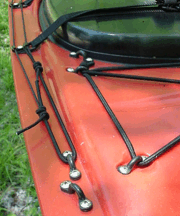 Most
kayak rudders will have a Lift Line (Perception Illusion photo right)
to allow the paddler to deploy and stow the rudder, on the back deck,
at will, while seated in the cockpit. This allows the rudder to be raised
during landing, launching and crossing shallows.
Most
kayak rudders will have a Lift Line (Perception Illusion photo right)
to allow the paddler to deploy and stow the rudder, on the back deck,
at will, while seated in the cockpit. This allows the rudder to be raised
during landing, launching and crossing shallows.
In most cases this line is a long loop and knotted near the cockpit. The farthest knot back is always the one to pull, as the knots change position each time you raise or lower the rudder. Remember that your rudder may have a "keeper cord" to lock it down to the deck during storage and transportation. Check to make sure this is off before launch.
Because the rudder blade can be raised or lowered it can also lift itself over a shoal, or submerged obstacle when paddling in a forward direction. It cannot however perform this function in a reverse direction.
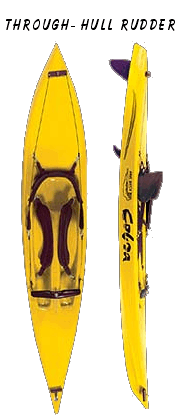 Some
kayaks, mostly surf skis, will sport Through-Hull rudders that are mounted
close to the stern, but not at the far end. Note the Cobra Wave Witch
photo (left). They protrude from the bottom of the hull and have shaft
that swivels in a tube that is through the hull. The top of the shaft
has a T-bar that attaches to the cables on the top of the back deck. This
is sometimes concealed by means of a cover plate.
Some
kayaks, mostly surf skis, will sport Through-Hull rudders that are mounted
close to the stern, but not at the far end. Note the Cobra Wave Witch
photo (left). They protrude from the bottom of the hull and have shaft
that swivels in a tube that is through the hull. The top of the shaft
has a T-bar that attaches to the cables on the top of the back deck. This
is sometimes concealed by means of a cover plate.
A Through-Hull rudder cannot be raised and lowered, it is always down. Care must be taken in shallow waters, kelp beds and beach landings & launchings. Other kayaks have a similar mechanism that is a streamlined, moveable segment of the hull at the very stern. This is less vulnerable to impact with submerged obstacles.
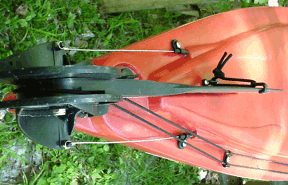 The
cables are almost always running through plastic tubes that poke out of
the back deck at the stern and poke out of the cockpit walls (sit-on-tops)
or (sit-in-sides) inside the hull, maybe through a bulkhead, connecting
rudder to the foot pedals. This keeps the water out of the hull. Some
kayaks will have the cables mounted externally on the deck. Photo courtesy Cobra Kayaks.
The
cables are almost always running through plastic tubes that poke out of
the back deck at the stern and poke out of the cockpit walls (sit-on-tops)
or (sit-in-sides) inside the hull, maybe through a bulkhead, connecting
rudder to the foot pedals. This keeps the water out of the hull. Some
kayaks will have the cables mounted externally on the deck. Photo courtesy Cobra Kayaks.
The foot control pedals usually consist of a foot peg mounted on a rail that has graduated slots for peg adjustment, fitting a variety of paddler leg lengths (photo below left). The rail is then mounted on a track that allows the foot peg & rail to slide freely forward and back, pulling the cable. To make the rudder turn one peg must go forward and the other back.
 One
problem with this system is that it requires the paddler to bend and
straighten the legs, affecting the grip/fit on one kayak. Those paddling
sit-ons will feel a looseness in their knee straps, those in sit-in
kayaks will have less contact with thigh brace pads, both types of paddler
will notice a decrease in control of the kayak and in ability to lean
and brace.
One
problem with this system is that it requires the paddler to bend and
straighten the legs, affecting the grip/fit on one kayak. Those paddling
sit-ons will feel a looseness in their knee straps, those in sit-in
kayaks will have less contact with thigh brace pads, both types of paddler
will notice a decrease in control of the kayak and in ability to lean
and brace.
This one fact alone has many paddlers avoiding rudders because loss of lean control and brace ability that can lead to a tip over, and that can be trouble for the decked kayak (sit-in) paddler. (Not so much for the open deck paddler.)
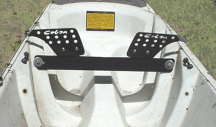 This
problem has been solved, and while still not widely available, we are
now seeing kayaks outfitted with "toe-control" foot pegs on
ruddered kayaks. (See photo Cobra Expedition left)
This
problem has been solved, and while still not widely available, we are
now seeing kayaks outfitted with "toe-control" foot pegs on
ruddered kayaks. (See photo Cobra Expedition left)
This means that the legs do not have to move, thus maintaining good contact and control of the kayak. Only the toes need move while the ball of the foot braces firmly against the main portion of the peg. A "toe control" rudder is standard stock for Cobra kayaks.
A rudder works by creating drag. When kept straight, like a skeg, it ensures that the stern of the kayak will want to move slower than the bow, keeping you from "fish tailing." The rudder also turns the kayak when the blade pivots to one side.
How Rudders Work:
 There
is more drag on the side of the kayak that the rudder is turned to, thus
slowing that side of the kayak, while the other side maintains its rate
of speed. While a rudder makes "steering" easy, it is in fact
consuming your hard won forward momentum, thus making you work harder
to get from point A to point B. Of course this is like the power steering
in your car, it draws power from the engine so you don't have to "muscle"
the steering wheel, but the gas mileage is less. Like power steering many
folks will find this a good trade off.
There
is more drag on the side of the kayak that the rudder is turned to, thus
slowing that side of the kayak, while the other side maintains its rate
of speed. While a rudder makes "steering" easy, it is in fact
consuming your hard won forward momentum, thus making you work harder
to get from point A to point B. Of course this is like the power steering
in your car, it draws power from the engine so you don't have to "muscle"
the steering wheel, but the gas mileage is less. Like power steering many
folks will find this a good trade off.
The rudder, for use with kayaks, is a relatively new innovation. The Inuit originators of the kayak did not use rudders on their kayaks. Significant numbers of kayak paddlers today adhere to that traditional simplicity of going rudderless. They also may be looking to save those extra calories wasted on drag. Indeed most kayaks do not need a rudder. Proper use of paddling stokes can provide all the control of your boat that you need. So, in effect skills can replace hardware.
 You
will see that many kayaks on the market have a rudder option, or even
come with a rudder as part of the standard package. A few kayak models
have a skeg option. A skeg is a fixed blade that does not move, kind of
like a surfboard fin. Many of the rudderless traditionalist like a skeg
to help their kayak track on a straight course, and some, as above, like
both. Photo courtesy Cobra Kayaks.
You
will see that many kayaks on the market have a rudder option, or even
come with a rudder as part of the standard package. A few kayak models
have a skeg option. A skeg is a fixed blade that does not move, kind of
like a surfboard fin. Many of the rudderless traditionalist like a skeg
to help their kayak track on a straight course, and some, as above, like
both. Photo courtesy Cobra Kayaks.
Do you want or need a rudder?
That question can be answered based on what kind of kayak, how that kayak will be used and in what conditions. Other factors will involve the skill level of the paddler and their personal preference. In simple terms, for average paddlers who are novice to intermediate, you can follow these guidelines:
- Those who wish to paddle on open water exposed to wind and waves will likely want a rudder.
- The longer the kayak is the more likely a rudder is standard equipment.
- The more time you invest in learning paddle strokes and skills the less you may want a rudder.
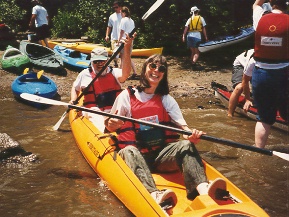 It
would be helpful to review: "Paddling
Straight."
It
would be helpful to review: "Paddling
Straight."
When choosing a new kayak it is wise to go for a test paddle. Rather than a five minute ride around a pond, it would be wise to try a new kayak out in real life conditions.
The best way to do this would be in a guided tour or kayak lesson setting where you have a chance to try several kayaks, with rudders, or not, in various waters. This way you can assess how the kayak handles. Lift up the rudder and go without. Drop it down and see how the rudder functions. Try rudder up and down in a variety of wind, wave and current directions.
Bear in mind that some rental and tour companies do not use rudders due to the extra wear and tear these boats receive. (Photo: Demo Day Fun at Turner Falls, MA)
Some kayak models can have the rudder added at a later date; other models must be installed by the manufacture. Consider your ability to do this sort of job at home or your access to skilled kayak technicians at a shop. While one can say that you can add a rudder later if you feel that you need one, a rudder installation is one of the more complicated modifications that can be made to a kayak. You may in fact decide to buy the rudder with the kayak and then feel that it is not necessary to use most of the time, but it will be there for you when needed, if not by you, then maybe some one borrowing your boat.
Choosing A Kayak With Rudders In Mind
I know of an arctic long distance wilderness kayaker who insists on having a rudder on his kayak, but he only uses it "seven percent" of the time! He is in a sense a purist that realizes that some water/weather conditions merit the use of the rudder. His reasoning is that a rudder requires harder work, and thus he burns more calories (food). Re-supply of his food is far and few above the Arctic Circle, and he can only carry so much in a kayak. So he does not use his rudder because of the drag. But when the winds and waves are working against him a rudder can in fact save calories by making steering easier. Photos below courtesy Johnson Outdoor.
 A
considerable many kayak models have no rudder option at all. (OK Frenzy
left). The main bulk of these are recreational kayaks that are shorter
and more maneuverable. While recreational kayaks are easy to turn they
are often harder to keep straight. Considering a rudder is best used to
keep the kayak straight, it is funny that they do not make rudders, or
at least skegs, available for these shorter kayaks. Bear in mind that
"rec" kayaks are not intended for use on open water. The designers
of these boats are counting on the fact that you will be paddling in fair
weather on clam waters, not far from shore.
A
considerable many kayak models have no rudder option at all. (OK Frenzy
left). The main bulk of these are recreational kayaks that are shorter
and more maneuverable. While recreational kayaks are easy to turn they
are often harder to keep straight. Considering a rudder is best used to
keep the kayak straight, it is funny that they do not make rudders, or
at least skegs, available for these shorter kayaks. Bear in mind that
"rec" kayaks are not intended for use on open water. The designers
of these boats are counting on the fact that you will be paddling in fair
weather on clam waters, not far from shore.
 The
categories of surf kayaks and white water kayaks will not feature rudders
either, with one exception. Surf kayaks and wave skis will often have
a skeg or several skegs mounted toward the stern on the hull, just like
surfboards and water skis. (Perception's Five-0 pictured right).
The
categories of surf kayaks and white water kayaks will not feature rudders
either, with one exception. Surf kayaks and wave skis will often have
a skeg or several skegs mounted toward the stern on the hull, just like
surfboards and water skis. (Perception's Five-0 pictured right).
The Wave Witch, a surf kayak that often defies classification due to it revolutionary, visionary even, design, features a through-hull rudder and in some cases skegs too! This kayak has a foot control mechanism that resembles the steering of those go-carts we made as kids, only hi-tech. White water kayaks do not have rudders, nor will you see skegs on them either.
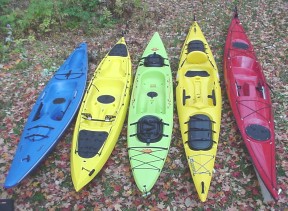 Touring
kayaks, sometimes called sea kayaks, are the boats that you will most
likely see rudders on. You may find that a rudder is standard equipment
on most that you will see. These kayaks are made for open water travel
and are built to handle wind, waves and currents. Touring kayaks are about
13 to 18 feet in length; surf skis can be as long as 20 feet or more.
A common size of the classic sea kayak is about 15 to 17 feet. Some touring
kayaks are difficult to make tight turns with, while a rudder can help,
in is easier to use skill, boat lean and proper strokes to change direction.
(Touring Kayaks L to R: Necky Dolphin- Yes, Cobra Tourer- Yes, OK Classic-
No, Wilderness System's Tarpon 160- Yes, Heritage Expedition- Yes)
Touring
kayaks, sometimes called sea kayaks, are the boats that you will most
likely see rudders on. You may find that a rudder is standard equipment
on most that you will see. These kayaks are made for open water travel
and are built to handle wind, waves and currents. Touring kayaks are about
13 to 18 feet in length; surf skis can be as long as 20 feet or more.
A common size of the classic sea kayak is about 15 to 17 feet. Some touring
kayaks are difficult to make tight turns with, while a rudder can help,
in is easier to use skill, boat lean and proper strokes to change direction.
(Touring Kayaks L to R: Necky Dolphin- Yes, Cobra Tourer- Yes, OK Classic-
No, Wilderness System's Tarpon 160- Yes, Heritage Expedition- Yes)
In general a kayak that tracks straight will be hard to "corner" while one that turns easily will not track straight well. Open water paddling is usually a matter of going from point A to Point B in a straight line. The straighter you keep this line the fewer calories you burn and the easier the navigation will be.
But kayaking is about fun too, spontaneity, play, seeing the sights and exercise, so burning those calories is a good thing after all! There is a certain "expression" that one can feel slaloming through the rock gardens like a dancer or a freestyle canoeist. Some folks will want to find a kayak that tracks well and is maneuverable at the same time. Certainly there are kayaks that allow for this, with or without paddling skills, but the addition of a rudder may be the way to achieve this, giving us lots of options in kayak selection.
Sit-on-top kayaks are well represented now in touring kayaks, rec boats, surf kayaks, white water boats and of course surf skis and wave skis. While many fall into the shorter rec kayak and surf kayak grouping, more and more are showing up in the longer faster touring and sea kayak class. Sit-ons are often wider and stable, knee straps are not as common and they should be, for many the center of gravity is high and as a result of these properties sit-on-tops do not always respond well to the J-Lean and locking or unlocking of the stern. (Both techniques used to maintain a straight course and/or used in turning.) So, I will step out on a limb here and say that if you paddle a sit-on you may be more likely to want a rudder on your kayak. Indeed one of the draws of the sit-on-top is there is less to learn, and a rudder can make up for lack of paddling skills to some degree. (Not seamanship however.)
Can A Rudder Break?
This brings me to another topic that I will weave in and out of. What happens if the rudder breaks? What will I do? A rudder after all is "moving parts" and subject to failure. While most rudders do not "conk out" it can happen. They are quite dependable, but if it does fail you will have to rely on your paddling skills. Failure of a rudder is never planned, it will happen by surprise, most likely when you need it the most. I highly advise you that you practice regularly in "adverse" conditions with paddling skills that you have learned from a kayak instructor. This way if and when the rudder fails you will be ready to handle the situation safely with skill.
What could go wrong with a rudder you ask? There are several things that do happen. There are also ways to "field repair", fix and prevent this, but that can be a whole new subject.
The most common is a broken cable. The rudder cable is often steel, like a brake cable for a bike. If it breaks the rudder will not work. This is often caused by corrosion in salt water, and a thorough fresh water rinsing, those long plastic tubes too, will prevent this. Steel cables require tools to fix. Spectra and other cord-like cables can also break, usually due to some kind of abrasion, maybe from harsh stern tie-downs while car topping. They can be "tied" in the field to jury rig, or with fresh cable and a sharp knife a complete rebuild can be performed.
Bent rudder blades will prevent you from effectively steering. Sometimes they can break right off. This will happen from impact on the bottom or submerged rocks in a rock garden. (If you like to paddle the rough and unpredictable waters of a rock garden a rudder would be something to leave off your kayak.)
Another bender and breaker of rudder blades is waves. Getting broached, sideways, in a breaking wave will put undue sideways stress on the rudder blade. The blade is very strong on the edge, but weak on the flat, like a butter knife. As the kayak is pushed sideways the rudder blade, maybe even the whole assembly, will be pushed sideways and bent or twisted. If this happens the blade can sometimes be re-bent, or hopefully you will at least be able to raise the blade and park it, while you "limp" home. Lift the rudder in surf zone situations that can lead to a broach to prevent this from happening.
Foot pegs can break off if you press too hard on them. Not that you will be "Stomping" on them but, some times there will be extreme conditions that can apply undo pressure, and snap them off. Usually it is a matter of the peg coming off the track, but breakage is not unheard of.
Lift lines can malfunction preventing lowering or lifting of the rudder blade. This can be a problem if you are alone, but a buddy can raise or lower the blade for you. If you are paddling a sit-on you could swim or straddle the deck to get to the rudder and move it.
What ever the problem, it can all be prevented for the most part by taking good care of the kayak. Most damage is from storage and transportation! So be careful and protect that rudder if your kayak has one. After all it adds about $150 - $200 or more, sometimes much more, to the cost of your boat.
Rudder Options On My Personal Kayaks:
Folks will ask me if I have a rudder on my kayak. I do for the most part. I have several kayaks, and those that have a decent rudder option have rudders installed. I have not always been a rudder user.
I used to feel that a rudder was too many moving parts, added costs and maintenance, reduced efficiency, and could be a danger in the surf zone if the kayak got loose. I started out with SOTs on Scuppers (Classics) and the original Scupper Pro. Back then they did not have a rudder option at all.
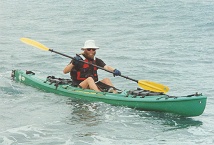 Then
Ocean Kayak upgraded the Pro and added a rudder option. I got mine without
one of course. I kept looking at the rudder mount on the end. It looked
so "empty." I wondered if I should mount a dive flag there,
maybe a towing ring. I was getting "rudder curious," had tried
a few of course, and had seen many getting them on their boats just
as a matter of course. Well I took the "plunge" and put one
on. It was easy to do myself.
Then
Ocean Kayak upgraded the Pro and added a rudder option. I got mine without
one of course. I kept looking at the rudder mount on the end. It looked
so "empty." I wondered if I should mount a dive flag there,
maybe a towing ring. I was getting "rudder curious," had tried
a few of course, and had seen many getting them on their boats just
as a matter of course. Well I took the "plunge" and put one
on. It was easy to do myself.
I started to use my new rudder a lot, just to see what it was all about and how I liked using it. Well I did like it. It made things easy. Yes, I had the skill to go without, but call me a gear head, I thought this bit of hardware was worth it. In fact the Ocean Kayak rudder is strong and suitable for kayak surfing (I don't recommend surfing with many other brand rudders) and that is a considerable advantage to handling the 15 ½ feet of Scupper Pro in the surf zone.
Now I like to get a rudder on a boat if it can take one. I use them less than I used to at first, but I would still say that the rudder is down a considerable amount of time on my kayak. (I don't mind burning the calories, I could stand to loose a few pounds.)
I know that I can always raise the rudder if not wanted and lock it down for better control of the kayak. I use steering strokes and leans, with or without the rudder down in my own "paddling style". I know that if the rudder gives out I will be able to handle it by paddling skill alone.
© 2004-9 Tom Holtey - This information page is provided courtesy of TopKayaker.com
